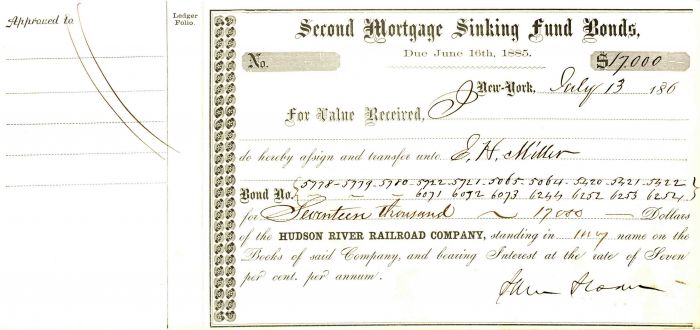Sam Sloan signed Hudson River Railroad Co. - Railway Bond Transfer Receipt
Inv# AG1553 Bond
Bond Transfer Receipt signed by Sam Sloan. Civil War dated! Portrait and biography included.
Samuel Sloan (December 25, 1817 – September 22, 1907) was an American politician, businessman and executive. He is most known for his tenure as the president of the Delaware, Lackawanna & Western Railroad (DL&W) for 32 years.
Samuel Sloan was born in Lisburn, County Down, Ireland to William and Elizabeth Sloan and moved to New York when he was one year old. He attended the Columbia College Preparatory school until he was 14, at the time of his father's death. After withdrawing, he became employed at an importing house in New York, eventually becoming the head of the firm.
Sloan was elected as a Supervisor in Kings County (Brooklyn) in 1852, and was president of the Long Island College Hospital. He became a director of the Hudson River Railroad in 1855, left the importing business in 1857 and was elected to the New York State Senate, where he served for two years.
He became a director of the Delaware, Lackawanna & Western Railroad in 1864, and became its president in 1867. Prior to accepting the DL&W Presidency, Sloan had declined an offer to become President of the New York and Harlem Railroad. He extended the DL&W rail lines, and the company achieved great success, in part due to the traffic generated for transport of anthracite coal mined in the railway's expanded territory. Passenger traffic also increased, particularly between New York City and the Pocono Mountains in Pennsylvania, a popular resort area.
Sloan resigned from the DL&W presidency in 1899, but continued as chairman of the board. He served on the boards of banks, utilities and other companies.
On April 8, 1844, Sloan married Margaret Elmendorf in New Brunswick, New Jersey, and moved to Brooklyn, New York. Margaret was a daughter of Peter Zabriskie Elmendorf and Maria La Grange (née Van Vechten) Elmendorf. They had eleven children, including:
- Peter Elmendorf Sloan (1845–1916), who graduated from West Point in 1865.
- Maria LaGrange Sloan (1847–1929), who married Edgar Stirling Auchincloss (1847–1892), parents of U.S. Representative James C. Auchincloss.
- Margaret Elmendorf Sloan (1854–1906), who married the Rev. Joseph Rankin Duryee (1853–1935) in 1883.
- William Simpson Sloan (1859–1896), who married Julia Rapallo (1862–1935).
- Elizabeth LaGrange Sloan (1862–1960), who married Joseph Walker Jr. (1858–1927), senior partner and president of the investment banking firm of Joseph Walker & Sons, in 1887.
- Samuel Sloan Jr. (1864–1939), a banker with Farmers' Loan and Trust Company who married Katherine Colt and inherited Oulagisket.
- Mary Adelaide Sloan (1868–1954), who married Richard Collins Colt (1863–1938), parents of banker S. Sloan Colt.
Sloan died in Garrison, New York, in 1907 at the age of 89, having been the president of seventeen corporations during his lifetime.
Samuel Sloan is the eponym of the city of Sloan, Iowa and the village of Sloan, New York.
Upon his daughter Margaret's 1883 marriage, he built "Wyndune" in Garrison as a wedding present for them near his own Garrison estate known as Oulagisket (later renamed Lisburne Grange by his son). Similarly, upon his daughter Elizabeth's 1887 marriage, he built "Walker House" in Garrison for them.
A statue memorializing Sloan was placed in Hoboken, New Jersey, originally facing the ferries in 1899. Some people criticized the statue's orientation, and the Mayor of Hoboken remarked that Sloan was "turning his back on the great city of Hoboken." On August 3, 1908, during the reconstruction of Hoboken Terminal, the statue was set facing both the town and the railroad and ferry stations.
The Troy and Greenbush Railroad was chartered in 1845 and opened later that year, connecting Troy south to Greenbush (now Rensselaer) on the east side of the Hudson River. The Hudson River Railroad was chartered on May 12, 1846, to extend this line south to New York City; the full line opened on October 3, 1851. Prior to completion, on June 1, it leased the Troy and Greenbush.
Cornelius Vanderbilt obtained control of the Hudson River Railroad in 1864, soon after he bought the parallel New York and Harlem Railroad.
Along the line of the Hudson River Railroad, the West Side Line was built in 1934 in the borough of Manhattan as an elevated bypass of then-abandoned street running trackage on Tenth and Eleventh Avenues. The elevated section has since been abandoned, and the tunnel north of 35th Street is used only by Amtrak trains to New York Penn Station (all other trains use the Spuyten Duyvil and Port Morris Railroad to reach the Harlem Line). The surviving sections of the West Side Line south of 34th Street reopened as the High Line, a linear park built between 2009 and 2014.
A bond is a document of title for a loan. Bonds are issued, not only by businesses, but also by national, state or city governments, or other public bodies, or sometimes by individuals. Bonds are a loan to the company or other body. They are normally repayable within a stated period of time. Bonds earn interest at a fixed rate, which must usually be paid by the undertaking regardless of its financial results. A bondholder is a creditor of the undertaking.










Ebay ID: labarre_galleries